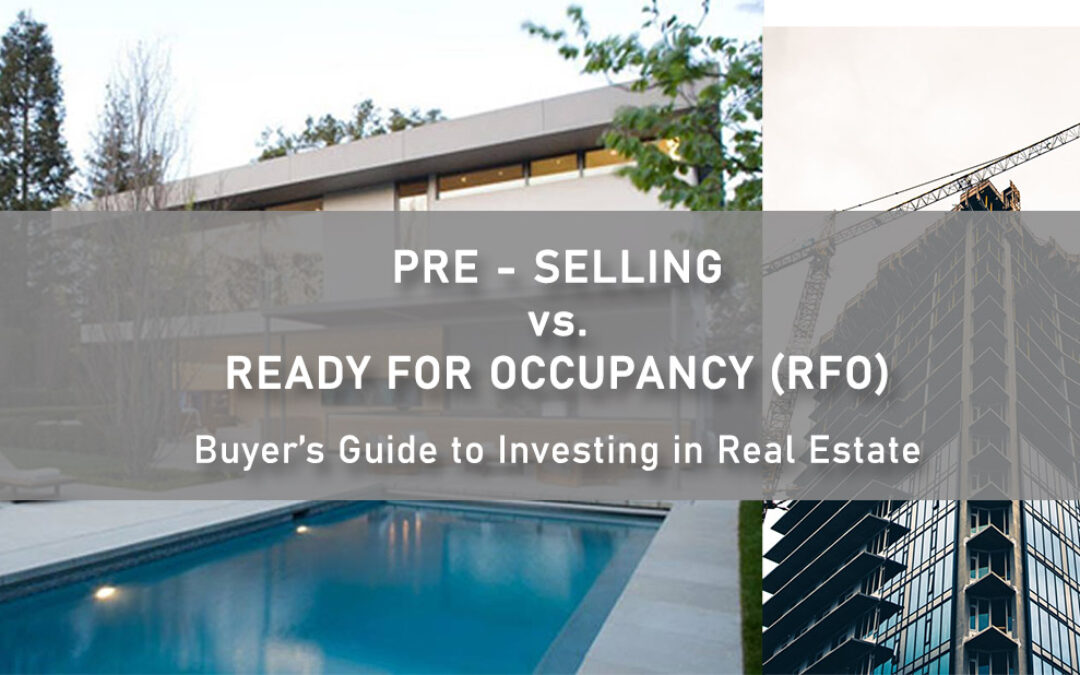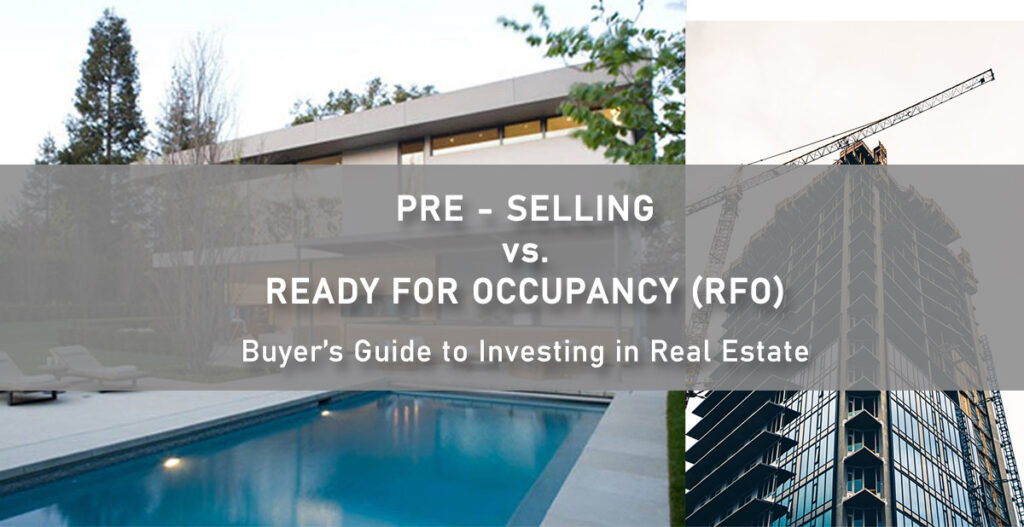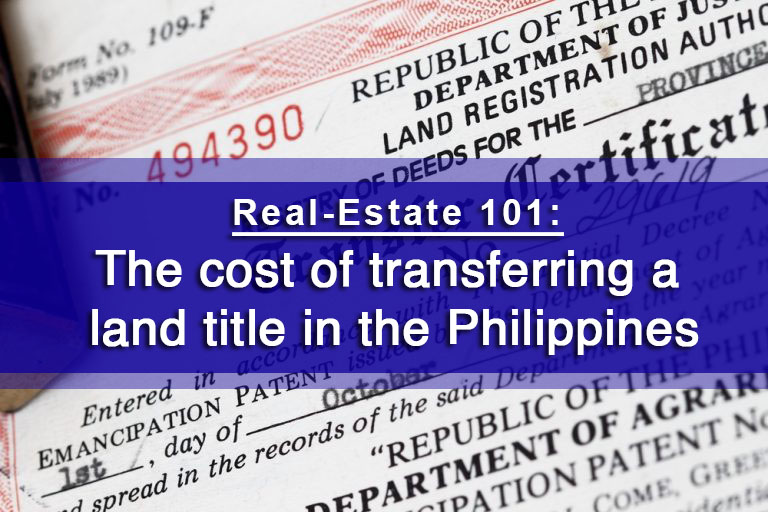
by Doah Sto. Tomas | Jul 1, 2021

How do you prefer to have your condominium or town house? Do you want to be the first occupant, or do you not mind living in a place that was previously owned by other occupants? Do you want to see the actual finished product before purchasing, or would you not mind investing in a building that’s yet to be finished?
Those are just some of the concerns often heard and talked about as clients scout for options regarding condominiums, house and lots, as well as town houses. Good for real estate developers and clients, there are two types of properties available in the market. Let us give you some useful information on what these options are.
What is Pre-Selling?
The term “pre-selling” refers to the condominium units or townhouses/house and lots that are sold prior to its completion. Real estate developers wanted to cater to clients who might not exactly have the budget to purchase the finished unit but has money in the bank enough to pay for a spot in a physical property.
One setback in pre-selling units is that you don’t get to appreciate the finished infrastructure because you don’t really get to see it until it’s really done. In fact, your expectations may be a tad different from what you will see when the final product is ready.
However, the good news is that there are dressed up and turn over condominium units, model townhouse units/ house and lots that your agent or broker can show you. It means that you don’t really need to do guesswork or blind buy into something costly.
Given these considerations, you might also want to get in touch with a developer with a good track record in terms of infrastructure and design so that you can at least enjoy the aesthetics as you envisioned it to be.
Is RFO for you?
After the building or property has been completed, it will be sold and RFO or “Ready For Occupancy.” If you need a roof on top of your head as soon as possible, then RFO is the way to go.
If you’re the type of client who wants to be guaranteed of quality in terms of construction and design before making a purchase, then RFO will allow you to examine the physical aspects – amenities and facilities — of your property. It will be easier for you to judge whether you will push through with your investment if you have seen it.
The potential issue with RFO is that most of the good units or home properties with good views and prime spots have been sold during the pre-selling stage. That would mean that the units that have been left will be your only choices.
Making your smart choice
Now that you’re well-versed in these terms, you can better weigh your options in case you’d like to invest in a real estate property. Pre-selling is financially more accessible to most potential clients, but it has its risks. RFO has lesser risks but indeed it’s heavier on the pocket.
Again, we advise you to get in touch with a real estate broker or a developer that has a good record that you can trust so that you will have more chances of making the right choice.
by Broker D | Jul 2, 2020

The cost of transferring a land title in the Philippines
We will be bringing you a series of articles that discuss commonly asked questions regarding real estate in general. One of the most commonly asked questions we encounter whenever we conduct trainings and orientation seminars for those interested to get into the real estate industry is “How much does it cost to transfer the land title”?
Buying property is generally considered one of the biggest steps a person can take in life, typically due to the large amount involved. But unlike other purchases that one can make, real estate is not something you can normally have by paying for in one quick transaction. Along with the property’s price are other expenses that come as part of the purchase. In this respect, the most important is perhaps the cost to transfer the land title.
For buyers or sellers, transferring the land title can prove to be a challenging experience. The paperwork involved and the fees that need to be paid can be daunting for first timers. With that said, let’s start off by discussing the fees associated with purchasing property. Let’s start off with the cost of transferring the land title. This fee needs to be paid whenever property is purchased, sold, donated or inherited. Having the land title under your name is very important as it serves as your proof of ownership of the property, regardless if you are a buyer, a donee or an heir. The absence of this document can lead to the ownership of your property being disputed. Therefore, it is imperative that you ensure the correct processing of this document. And one of the ways to ensure this is to pay all the required fees and taxes.
The following are the fees and taxes that you need to be aware of. The amount of these fees and taxes are based on how much the property cost at the time of the transaction or transfer:
- Any Unpaid Real Estate Taxes due – always check if the property you are buying has any unpaid real estate taxes particularly if you are buying property directly from the owner
- Capital Gains Tax (CGT) – this is computed as 6% of the selling price specified on the Deed of Sale or the Zonal value, whichever amount is higher
- Withholding Tax – this only applies when the seller of the property is a corporation (e.g. a land Developer)
- Transfer Tax (Local Treasurer’s Office) – this is tax imposed on the sale, barter, or any other method of transferring of the ownership or title of real property, at the maximum rate of 50% of 1 percent of a property’s worth (in the case of cities and municipalities within Metro Manila, this is 75% of 1 percent)
- Transfer Tax (BIR) – Transfer taxes may also be owed to the Bureau of Internal Revenue. If the property was donated, the Transfer Tax is in the form of Donor’s Tax. If the property was transferred via inheritance, this is in the form of estate tax.
- Documentary Stamp Tax – this is commonly set at 1.5 percent of the selling price, or the zonal value or fair market value, whichever is higher.
- Registration Fee – commonly set at 0.25 percent of the selling price, or zonal value or fair market value, whichever is higher.
- Commission of the Agent and/or Broker
- Incidental and miscellaneous expenses – typically any expense incurred in the registration process, such as notary fees, etc.
The total amount of all these fees and taxes is the cost of transferring a land title. As you can see, all these fees and taxes can quickly add up.
Now, closely related to this topic is another question often asked immediately afterwards: “Who should shoulder the Land Title Transfer expenses?”
The common practice in the Philippines is that the seller is responsible for the following:
- Capital Gains Tax
- Withholding Taxes
- Any unpaid real estate taxes that are due
- Commission of the Agent and/or Broker assisting in the completion of the transaction
The buyer on the other hand, takes care of the following:
- Documentary Stamps
- Transfer Taxes
- Registration Fees
- Incidentals and miscellaneous expenses incurred in the registration process
This arrangement is considered standard practice. But in other cases, the buyer and seller can also mutually agree on who pays for what during the negotiation period, when the Deed of Sale (a.k.a. Deed of Absolute Sale) has not been signed yet. This document shows the legal transfer of real estate property ownership and is submitted to the Registry of Deeds for filing after the buyer pays the Documentary stamps, transfer tax and registration fees for the aforementioned Land Title Transfer.
As you can see, the entire process and everything involved can prove to be very burdensome to both buyer and seller. Since most buyers are willing to pay millions to buy property, it is sometimes worth it to engage a company that specializes in land title transfers in order to take the burden away from the buyer and seller. This also ensures that the transfer is done correctly and completely.
The post Real-Estate 101: The cost of transferring a land title in the Philippines appeared first on PHILREP Realty Corp..
by SYSTEM ADMIN | Oct 4, 2019
If you have a knack for marketing, buying-and-selling, and you have that client-comes-first, positive attitude and never-say-die personality, the real-estate industry is one of the most rewarding jobs you can venture into right now.
Most people who are really good at selling normally start out on a small scale. You’ll see a lot of enterprising individuals (a lot of them OFWs) who sell their hand-me-downs for affordable prices on FB live and make a good profit. They’re usually good at building rapport with their target audience and this is a critical skill for anyone in the buy-and-sell business.
A lot of aspiring real-estate sellers have experience and good people skills, but why are most of the folks I talk to hesitant to get into real-estate selling? One of the biggest challenges I have observed with the people I’ve interacted with boils down to the fact that they get overwhelmed by the price tag of what they’re selling. Most of them have been used to selling items that range in the hundreds to couple of thousands of pesos. But in real-estate, they suddenly have to sell properties that can be anywhere in the hundred of thousands up to several millions of pesos. And the price tag somehow intimidates most of them.
I’ve been in the same boat before, so I can understand how they feel, I used to be part of a startup IT company earlier in my career. One of my roles included coming along with the marketing team to present our proposal to clients. As a technical person, that was the time I had to quickly learn how to explain and justify to clients why the solution they were buying was so expensive. Trial by fire experiences come one after another, some worse than others, but I took it all in stride, because I learned what I did correctly, and more importantly, I learned what NOT TO DO in the future. So here’s my unsolicited advice to all you aspiring real-estate sellers…
You are selling something of great value to someone. It is not just a structure built out of concrete and steel, it is a FUTURE HOME of a family. It is where fond memories will be built upon and preserved. These intangible things are PRICELESS and cannot easily be assigned a monetary value.
If you are still not convinced, think of if this way: Do not look at the total contract price, think in terms of Monthly Downpayments and Amortizations instead. It becomes easier as you look at the bigger picture. Also, your client is making an INVESTMENT that can pay for itself in the future if they decide to rent/lease out their property. Real-estate very rarely depreciates in value after all.
And if you do your job well and show your client that you actually care about their dream of finding a HOME, then just might be pleasantly surprised at repeat business and referrals from your happy clients!
HAPPY SELLING EVERYONE!!!
About the author:
Jay Dominic Sto. Tomas is a board member of PHILREP Realty Corporation and a certified IT Architect at IBM
The post I WANT TO GET INTO REAL-ESTATE SELLING BUT… appeared first on PHILREP Realty Corp..



